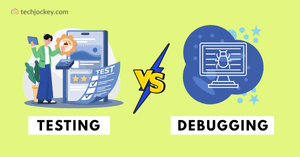Best Debugging Software
(Showing 1 - 20 of 21 products)

TotalView
Brand: Perforce
(0 user reviews)
With TotalView, you can quickly identify and resolve issues, improve performance, and ensure the stability of your applications. TotalView is trusted by le... Read More About TotalView
Price On Request

SonarCloud
Brand: SonarSource
(0 user reviews)
SonarCloud helps developers identify and fix bugs, vulnerabilities, and code smells in real-time. It integrates with various CI/CD pipelines to ensure cont... Read More About SonarCloud
Price On Request

Rollbar
Brand: Rollbar
(0 user reviews)
Rollbar is a real-time error tracking and resolution tool with automation, prioritization, and features to improve code quality.... Read More About Rollbar
$19 /Month

Rogue Wave Totalview
Brand: rogue-wave
Rogue Wave TotalView is the best debugging software, Faster fault isolation, improved memory optimization, and dynamic visualization for your high performa... Read More About Rogue Wave Totalview
Price On Request

Gdb
Brand: GDB
(0 user reviews)
GDB is the best debugging software, the GNU Project debugger, allows you to see what is going on `inside' another program while it executes -- or what... Read More About Gdb
Price On Request

GNU DDD
Brand: Free Software Foundation
(0 user reviews)
GNU DDD is a graphical user interface for command-line debugging software like GDB/CUDA-GDB.... Read More About GNU DDD
Price On Request

Fiddler
Brand: Progress Software Corporation
(0 user reviews)
Fiddler is a powerful web debugging proxy that helps monitor, analyse, and modify HTTP traffic, streamlining the debugging process and providing valuable i... Read More About Fiddler
$12

Backtrace
Brand: Backtrace
(0 user reviews)
Backtrace is a debugging platform that provides comprehensive crash and error reporting, enabling developers to quickly identify and resolve software issue... Read More About Backtrace
$600

Memfault
Brand: Memfault
(0 user reviews)
With Memfault, you can track device metrics, analyse crash reports, and receive alerts for potential problems. Its user-friendly interface and powerful ana... Read More About Memfault
$1,500

Lumigo
Brand: Lumigo
(0 user reviews)
Using Lumigo, you can gain deep visibility into your applications' performance and behaviour, identify and resolve issues quickly, and ensure the reliabili... Read More About Lumigo
$99

Bugsee
Brand: Bugsee
(0 user reviews)
Bugsee is a bug and crash reporting tool for iOS and Android apps that captures video, logs, and network data.... Read More About Bugsee
$139 /Month

Tracealyzer
Brand: Percepio
(0 user reviews)
Tracealyzer is a powerful software tool that helps businesses debug, diagnose, and troubleshoot complex systems. It provides real-time observability, custo... Read More About Tracealyzer
Price On Request

Rookout
Brand: Rookout
(0 user reviews)
Rookout is a debugging and data collection platform that allows developers to collect real-time data from their live code, enabling them to debug and under... Read More About Rookout
Price On Request

Instabug
Brand: Instabug
(0 user reviews)
Instabug is a mobile app debugging and performance-enhancing tool that provides features for testing, monitoring, and improving user experience.... Read More About Instabug
$299 /Month

NerdVision
Brand: NerdVision
(0 user reviews)
NerdVision is a software tool designed to simplify debugging and troubleshooting in software development, offering real-time insights into code execution a... Read More About NerdVision
Price On Request
₹240 /month

BlackBox AI
Brand: BlackBox
BlackBox AI Debugging Software empowers developers with advanced automated debugging capabilities, swiftly pinpointing and resolving software issues, enhan... Read More About BlackBox AI
$20 /Quantity

Qt Creator
Brand: Qt Group
(0 user reviews)
Qt Creator is a cross-platform AI-enabled integrated development environment (IDE) designed to create GUI applications.... Read More About Qt Creator
$379

Xcode 15
Brand: Apple Inc
(0 user reviews)
Xcode 15 is Apple's application development platform that helps in creating apps across all Apple platforms.... Read More About Xcode 15
Price On Request

Visual Studio Code
Brand: Microsoft Corporation
Visual Studio Code is a powerful text editor that offers extensive customization options and a wide range of features, including intelligent code suggestio... Read More About Visual Studio Code
Price On Request
- 1
- 2
-
Last Updated on : 22 Dec, 2025
Debugging Software Comparison









